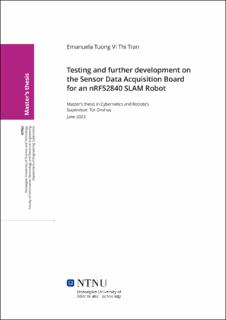| dc.contributor.advisor | Onshus, Tor | |
| dc.contributor.author | Tran, Emanuela Tuong Vi Thi | |
| dc.date.accessioned | 2023-10-04T17:21:14Z | |
| dc.date.available | 2023-10-04T17:21:14Z | |
| dc.date.issued | 2023 | |
| dc.identifier | no.ntnu:inspera:140443607:34518515 | |
| dc.identifier.uri | https://hdl.handle.net/11250/3094264 | |
| dc.description.abstract | Hensikten med denne masteroppgaven har vært å videreutvikle et nytt system, kalt Sensor Data Acquisition Board, slik at det kan integreres på nRF52840DK SLAM-robotene.
Høsten 2022 ble den første prototypen designet. Den har to nRF52840 SoCs der den ene
er utpekt til å kjøre oppgaven vedrørende IR-sensortårnet, mens den andre er utpekt til
å kjøre SLAM-algoritmer. Designfeil ble oppdaget etter det første designet, men det ble
ikke konkludert med behov for en ny revisjon. Målet med denne oppgaven har vært å
teste det nye systemet videre, vurdere behovet for en ny revisjon av kretskortet, og starte
programvareutviklingen av systemet. Dersom kritiske designfeil skulle oppdages, må en
ny revisjon av systemet startes.
Omfattende maskinvaretesting har blitt utført på den første prototypen av Sensor Data
Acquisition Board. I tillegg til de kjente mindre feilene i konstruksjonen, ble det oppdaget kritiske konstruksjonsfeil. Layoutdesignet for nRF52840 SoC ble gjort feil, slik
at spesifikke pinner ikke var tilgjengelige. Designfeilen gjelder de to nRF52840 som er
tilgjengelig på kretkortet. Dette førte til kretsfeil for flere kritiske kretsmoduler som SPI,
PWM, I2C og UART. Etter å ha identifisert feilene i det opprinnelige designet, ble det
utviklet en ny revisjon for å rette opp problemene.
Den andre revisjonen av systemet har nå korrigert oppsettet rundt nRF52840. Ved bruk av
µVias er alle pinner som ikke er tilgjengelige ved ruting på topplaget tilgjengelig på andre
lag. Den andre revisjonen har også adressert de mindre feilene som var kjent tidligere
og de som ble oppdaget under testing. Det ble laget en prioriteringsliste for å fordele
tidsbruken effektivt.
For å starte programvareutviklingen ble det utført en analyse av gjeldende programvare,
som er relevant for denne oppgaven, på SLAM-robotene. Analysen resulterte i en kravog spesifikasjonsliste for det nye systemet, og denne oppgaven har formulert et designforslag.
Parallelt ble det satt i gang et samarbeidende sideprosjekt med sikte på å forbedre og organisere SLAM robotprosjektet med involvering av de fire studentene i prosjektet. Denne
oppgaven presenterer forbedringene, modifikasjonene og bidragene fra forfatteren av
denne oppgaven til det overordnede robotprosjektet, og tar for seg dets dårlige vedlikeholdsmuligheter.
Denne oppgaven avslutter den første fasen av et nytt innebygd design, og etablerer
grunnlaget for den andre revisjonen av Sensor Data Acquisition Board og starter programvareutviklingen for det nye systemet. Integrering av det nye systemet med den
nåværende roboten byr på utfordringer siden robotprosjektet ikke har den modulariteten som trengs for å integrere nye systemer. | |
| dc.description.abstract | The purpose of this master thesis has been to further develop a new system, called Sensor
Data Acquisition Board, such that it can be integrated on the nRF52840DK SLAM robots.
In the autumn of 2022, the first prototype was designed. It features two nRF52840 SoCs
where one is designated to run the task concerning the IR-sensor tower, while the second
is designated to run SLAM algorithms. Design faults were discovered after the first design, but it was not concluded the need for a second revision. The objective of this thesis
has been to test this new system further, review the need for a second revision of the
printed circuit board, and start the software development of the system. If critical design
faults were to be discovered, a second revision of the system must be started.
Extensive hardware testing has been done on the first prototype of the Sensor Data Acquisition Board. In addition to the known minor faults in the design, critical design faults
were discovered. The layout design for the nRF52840 SoC was done incorrectly, such that
specific pins were not accessible. The design fault concerns the two nRF52840 that are
available on the board. This led to circuit faults for several critical circuit modules such as
Serial Peripheral Interface (SPI), Pulse Width Modulation (PWM), Inter-Integrated Circuit (I2C) and Universal Asynchronous Receiver-Transmitter (UART). After identifying
the faults in the initial design, a second revision was developed to rectify the issues.
The second revision of the system has now corrected the layout around the nRF52840.
With the use of µVias, all pins not accessible by routing on the top layer are available on
other layers. The second revision has also addressed the minor faults that were known
earlier and the ones discovered during testing. A priority list was made to distribute the
time used effectively.
To begin the software development, an analysis of the current software, which is relevant
to this thesis, was conducted on the SLAM robots. The analysis resulted in a requirement
and specifications list for the new system, and this thesis has formulated a design proposal.
In parallel, a collaborative side project aimed at improving and organizing the SLAM
robot project was initiated with the involvement of the four students on the project. This
thesis presents the enhancements, modifications, and contributions made by the author
of this thesis to the overall robot project, addressing its poor maintainability.
This thesis concludes the first phase of a new embedded design, establishing the groundwork for the second revision of the Sensor Data Acquisition Board and initiating the
software development for the new system. Integrating the new system with the current
robot poses challenges since the robot project does not have the modularity needed
for integrating new systems. | |
| dc.language | eng | |
| dc.publisher | NTNU | |
| dc.title | Testing and further development on the Sensor Data Acquisition Board for an nRF52840 SLAM Robot | |
| dc.type | Master thesis | |
